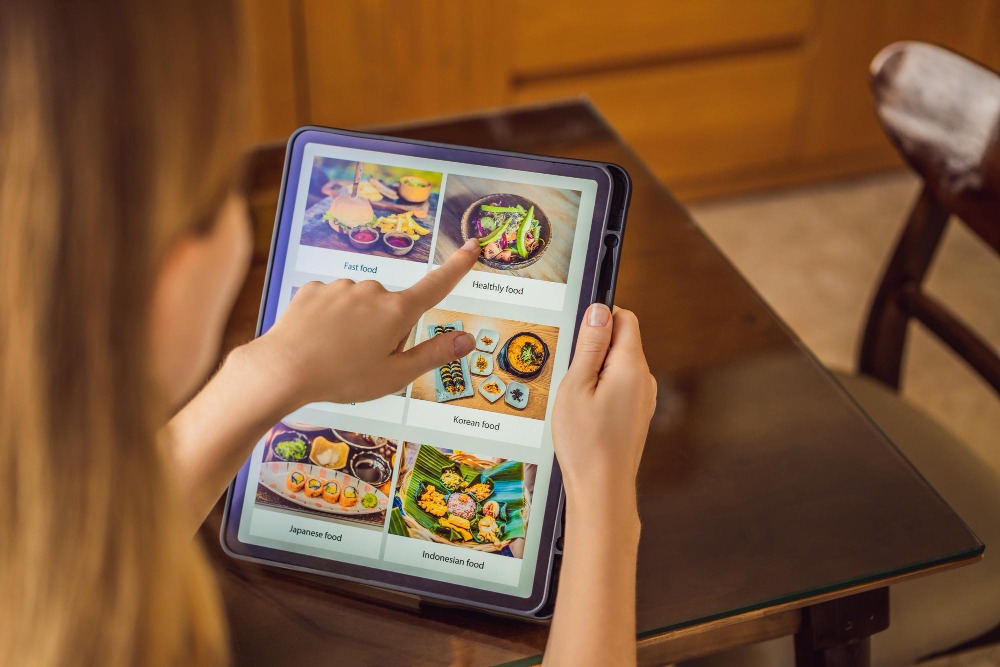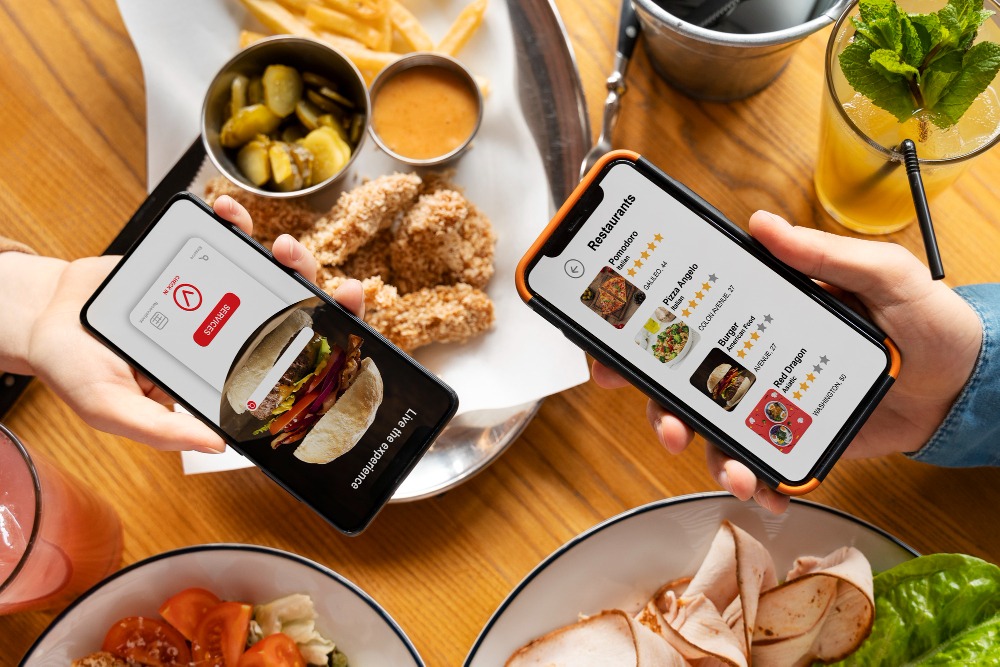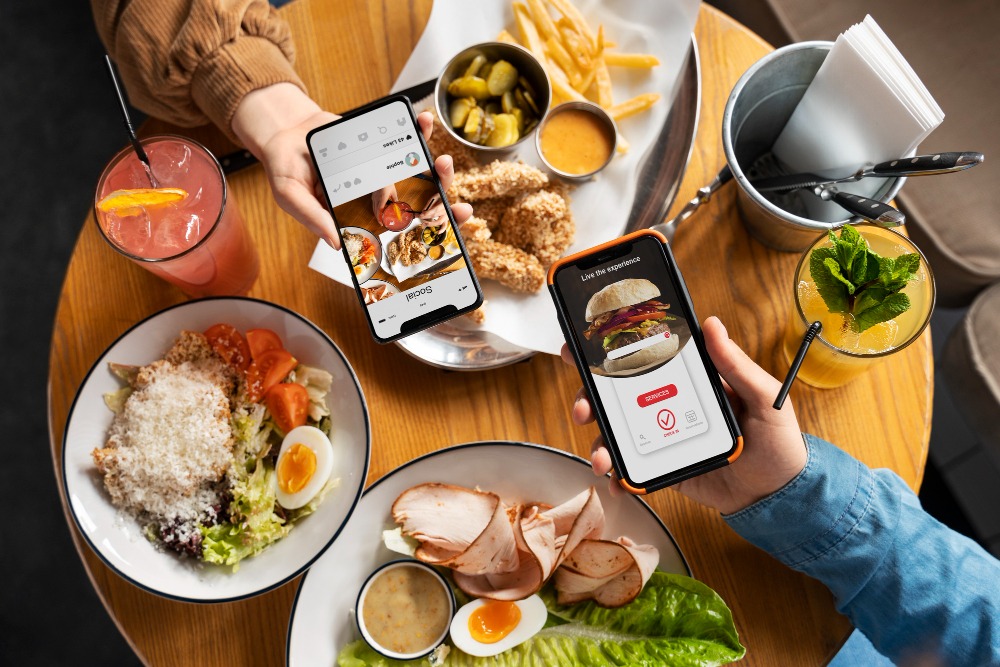Diving into the Future: A Comprehensive Guide to Mastering Digital Menus in the Restaurant Industry
- 1 An electronic menu board—What is it?
- 2 Types Of Digital Menu
- 3 How do digital menu boards work?
- 4 What is the best way to set up an electronic menu board?
- 4.1 STEP 1: find out the ROIs.
- 4.2 STEP 2: Setting a Financial Plan
- 4.3 STEP 3: Installing Hardware and Software
- 4.4 STEP 4: Supervision of Content
- 5 How To Design The Art and Science of Innovative Digital Menu Design?
- 5.1 Choose the right font, colour, and layout
- 5.2 Utilize menu engineering
- 5.3 Write illustrative item descriptions
- 5.4 Include images and videos
- 5.5 Device and screen size optimization
- 5.6 Make it convenient
- 6 Why Are Digital Menus Important?
- 6.1 1) Improved PR
- 6.2 2) Cheap Solution
- 6.3 3) Customization
- 6.4 4) Branding Chances
- 6.5 5) Clearer Menu
- 6.6 6) Special Event customization
- 6.7 7) Expand Your Options
- 6.8 8) Simplify
- 6.9 Is It Good To Change The Old Form To The New One?
- 7 Conclusion
- 8 Frequently Asked Questions
The most recent trend in the restaurant business is digital menus. Therefore, to distinguish themselves from the competition, restaurant owners are implementing computerized menus.
Customers interested in learning more about a certain company will find them particularly helpful. However, they can also be useful for regulars who are trying to find a different dish. Making a menu using that way was a real pain. The restaurant workers had to put in a lot of work for it. Therefore, making paper menus is likewise an error-free and time-consuming procedure.
It can take up to five hours per person, each day, to create a paper menu, according to reports. There has been a vast change in the last decade when it comes to restaurant technology. Additionally, only pizza places and other chain restaurants have digitized menus. However, in recent years, computerized menus qr code have grown in importance for eateries across the board.
An electronic menu board—What is it?
A digital menu board is an electronic replacement for a paper or chalk menu. To showcase their menu items, restaurants, and grocery stores utilize digital menu boards, which use electronic displays like video walls or flat screens with LEDs or LCDs.
Customers have a more interesting and interactive experience with electronic menu boards. Compared to the old-fashioned static menu boards, they’re far better. By changing to digital menus, you can cut down on printing expenses and paper waste, fix mistakes quickly, and make real-time updates—like taking sold items off the menu—in an instant! In addition, the exceptional brightness and sharpness of digital menu boards make them very attractive to customers.
Digital menu qr code boards have recently been implemented by the majority of restaurants and quick-service chains to enhance the dining experience for customers.
| FEATURES | DESCRIPTION |
| Digital Interaction
| Interact with ease thanks to an attractive and intuitive interface. |
| Constant Updating
| Quickly update to incorporate new offerings, sales, and discounts. |
| Multimedia Integration | Add multimedia to each meal with pictures, videos, and descriptions. |
| Personalization Choices | Give customers the option to tailor their orders according to their tastes. |
| Easily Accessible QR Codes | Quickly peruse menu items with the use of QR codes. |
| Multilingual Assistance | Provide linguistic alternatives to cater to a wide customer base. |
| Allergen Information | Detailed information on allergens and dietary restrictions should be provided. |
| Tailoring Your Order | Permit changes like additional toppings or sides. |
| Pos system integration | Streamlined order processing by seamless connection with point-of-sale systems. |
| Data Science and Analysis | Collect information about the most ordered items, busiest times, and customer tastes. |
| Options for Digital Payments | Permit easy and safe online payment options. |
| Anticipated Wait Times | Provide the anticipated wait periods for every order. |
| Possible Upselling Occasions | The emphasis should be on sales or suggested supplementary products. |
| Method for Receiving and Actuating Criticism | Gather evaluations and feedback from customers to help with ongoing improvement. |
| Potential Effects on the Environment | Lessen the amount of paper that is wasted and help with sustainability initiatives. |
Types Of Digital Menu
Digital Menu Options Thanks to advancements in communication technology, serving clients has never been easier or faster. This is the rationale behind the variety of online menus. You can choose between a classic paper menu and easy-to-use customization tools. Additionally, a fully functional interactive touch-screen is available for use. In the current restaurant industry, small, independent eateries are light years ahead of the competition.
Traditional Online Menus
Improving the customer experience can be done at a cheap cost with digital menus. The logic behind this is that they make use of preexisting gear. Through the screen, customers may view visual representations of the culinary items they order. Customers can personalize their orders by dragging and dropping images on the screen. Plus, they make it easy to personalize specific instructions.
Interactive digital menu
The digital menu is interactive and showcases high-quality video on a huge touch-screen. Menu items can be selected by customers using either their fingers or an electronic pen. After that, the server will be notified that an additional customer has placed an order.
The result is less wait time and simpler ordering. Users can also participate in games and contests through a few of these menus. They can also play around with exclusive elements, such as music videos, or obtain vouchers. A well-liked and easy method to reduce expensive charges and expand the organization.
The menu can be accessed digitally on the smartphone. The digital mobile menu is made for clients who are always on the move. Customers can use their phones to access the menu instead of paper. Before placing an order, they can view product photos and details. An updated digital application is readily available for download by customers.
Digital Drive-Through Menu
You can place your order from any vehicle using a drive-through menu. Additionally, for a long time now, IT has been helping the automotive industry streamline its processes. The digital menu available at the drive-thru, however, is both user-friendly and intriguing.
The reason behind this is that it can receive orders from clients even before they exit their automobiles. Therefore, it guarantees that restaurants are making the most of each customer’s time. Consequently, it will effortlessly boost sales and strengthen brand loyalty.
| Pros | Cons |
| Improved User Interface | Initial Setup Costs |
| Updating in Real-time | Technical Issues |
| Reduced printing costs | Dependence on smartphones |
| Data and Analytics | Security and Privacy Concerns |
| Adaptability and Flexibility | Resistance to Change |
| Efficient Order Processing | Dependency on PowerSource |
How do digital menu boards work?
Media players and software power digital menu boards. However, screen menus can be displayed in several ways.
- A crude method is first:
- Digital menu design
- Soft-copy the menu to a USB disk.
- Plug the USB into a TV or commercial monitor.
- Play menu.
- It works like a screen slide. USB-mediated playback has various drawbacks.
- Digital menu board software is recommended for driving display material. All sorts of software exist:
- It might be a normal digital signage software that creates and publishes menus, or
- An interactive menu program allows self-ordering.
- Both aspects are possible.
What is the best way to set up an electronic menu board?
Many factors must be thought about while establishing a digital menu board, including budget, industry standards, content management interface, etc. When configuring your digital menu display, keep these things in mind.
STEP 1: find out the ROIs.
Determining the objectives and anticipated returns on investment (ROI) is crucial before implementing a digital menu board system. As a result, it’s easier to choose the displays’ sizes, locations, and content types.
A smaller digital menu board near the entrance is one option for a restaurant that wants to advertise its daily specials. However, a centrally controlled network of menu boards in the cloud might be necessary for a fast food company with many locations.
STEP 2: Setting a Financial Plan
It is critical to choose digital screens, media players, and software that are consistent with the demands of the company. Then there are the financial factors to think about. Take, for example, the price range for 32–55-inch entry-level menu board displays, which can be anywhere from $300 to $1,000.
If you have technical knowledge or access to tech support, though, Raspberry Pi can be a fantastic, inexpensive piece of technology for setting up your digital menu boards. It is a desirable choice because of its small size and low power consumption.
STEP 3: Installing Hardware and Software
Just like any other type of digital signage, digital menu boards are styled:
Digital screen setup and security.
In certain cases, linking displays to media players. Links to the content management system (CMS) or digital menu board software for signs. At last, we’ll check the operation of the interface and content rendering by testing the hardware and software. Businesses should emphasize systems that allow for system interaction with third-party software, as well as systems that allow for remote updating and troubleshooting, inventory management, point-of-sale and invoicing, and more.
STEP 4: Supervision of Content
After your restaurant’s digital menu board is prepared to show menus, deals, and promotions, make use of your content management system, which is also called digital signage or software for digital menu boards.
The art of crafting an effective presenting strategy. Using design tools to create menus. Formal, up-to-date menus are present on all screens.
Assessing the impact of material with analytics
How To Design The Art and Science of Innovative Digital Menu Design?
Use these digital menu design best practices to maximize sales and guest satisfaction.
Choose the right font, colour, and layout
The digital menu should be easy to see and navigate. Follow these design basics to meet that condition.
Choose a sans-serif typeface for legibility. On-screen readability is improved by using thick fonts. Set contrast and intelligibility above all else when choosing colours. Black-and-white is classic and easy to read. What about your brand colors? Use them to highlight your digital menu. Your brand color, such as orange, could be used to highlight your most popular dishes.
The layout of your digital menu should be optimized for different devices. Interactive, mobile digital menus should be vertically scrollable, but static TV menus should be horizontal. Tabs make dynamic mobile ordering menus easier to navigate.
Want these tips demonstrated? View BRGR’s online ordering menu. Dark writing on a light background makes the menu simple to read. It uses the brand’s colors—black and turquoise—to create a stylish design that reflects BRGR BRGR.
The online ordering menu is easy to navigate because it has tabs for BRGRS, sides, and drinks.
Utilize menu engineering
After learning digital menu design, try menu engineering. Menu engineering boosts sales of your most profitable goods and boosts the popularity of others. Menu engineering includes adding icons like stars next to your most popular products to draw attention. You can also reduce your menu because too many alternatives make it harder for customers to choose.
Write illustrative item descriptions
Digital menus are great since each item can have unlimited space. Design your menu so customers may see additional details when they tap an item. Use descriptive item descriptions to attract customers and provide allergen information. Consider side and drink combinations to enhance cross-selling. All of this information minimizes the amount of inquiries servers must answer, which could impede ordering.
Include images and videos
Restaurant digital menus with unlimited space allow you to incorporate images and videos of every dish. Photos help clients decide, especially when they’re trying a new food. Appetizing photographs can boost sales. Rather than photographing every item on your menu, photograph the most profitable ones to boost sales. Here’s Freshwater Tavern’s menu, including photographs of appetizers, entrees, and more.
Device and screen size optimization
Initially, a static PDF menu is fine for your website, but a dynamic, mobile-friendly digital menu is better. Customers find responsive menus easier to use since they adapt to screen sizes. Fortunately, most digital menu software is mobile-friendly.
Make it convenient
Your digital menu must be accessible to disabled consumers by law and the right thing to do. The ADA and ACA in the US and Canada define digital barrier removal criteria.
Why Are Digital Menus Important?
New growth is focusing consumers on digital menus. These menus are popular for several reasons:
1) Improved PR
Customers may easily expand enterprises and share experiences on social media. When ordering, customers can upload photos on Facebook or Twitter. Or, they can leave reviews after receiving their food.
2) Cheap Solution
A computerized menu is cheap. Businesses with small budgets and staff can use digital menus. Businesses can aid ordering using these features. It expands product and service information. Using a digital menu is far cheaper than hiring more workers to process high-volume orders.
3) Customization
Restaurant guests can tailor their experience using digital menus. Drive-through orders can be made ahead of time. Or they can modify their meal before entering. These menus enable restaurants to personalize customer experiences. Increased loyalty and sales can result.
4) Branding Chances
Business owners can promote their brands with digital menus. These computerized menus contain several interactive aspects. Customers have a cause to communicate with the restaurant on social media or in person. Customers can play games or enter draws while ordering.
5) Clearer Menu
Customers can avoid menu confusion using digital menus. Items’ availability and extra costs are known. A digital menu makes ordering easy because customers can see all the options.
Digital menus reduce wait times by 30%. Digital menus let diners customize their meals. People get their food without waiting.
6) Special Event customization
Restaurants advertise holidays and special events on digital menus. Restaurant lobster feast menus may include expensive delicacies.
Digital screens can promote brand-backed events. Customers are easily drawn to the menus.
7) Expand Your Options
Installing new opportunities in your business can teach you about them. You must consider all your alternatives. This clarifies digital menu use.
8) Simplify
Customers appreciate simple, user-friendly tech. Thus, restaurants should simplify their digital menus. It restricts text on each screen. It also provides item descriptions and quick navigation.
Is It Good To Change The Old Form To The New One?
Digital menu boards can be connected to various business tools and software systems through the use of API interfaces. These systems include point-of-sale (POS) software, self-ordering systems, and inventory management systems. There is a rapid transfer of data between the systems thanks to integrations, which results in the creation of intelligent restaurant ecosystems.
- Personalized recommendations should be delivered.
- Decisions regarding pricing and products should be made based on logic and evidence.
- Evaluate the success of the marketing effort.
- The burden of manual chores should be reduced, and resources should be deployed efficiently.
Conclusion
Digital menus, which were initially used to prevent touch during the epidemic, have become popular in the hospitality business for their capacity to increase profits and efficiency. Digital menus change restaurant-customer interactions. Paper menus are still used by most eateries. That system is ineffective in the age of mobile browsing.
They display the whole menu on the restaurant’s website or mobile app. Digital screens clarify menus. It makes digital ordering simple for everyone. simple and easy.
Frequently Asked Questions
What is a restaurant’s digital menu?
An online restaurant menu can be viewed on a smartphone or tablet by scanning a QR Code on the table. It lets café, bar, and restaurant clients browse the menu without waiting for a server.
How to interpret digital menus?
Steps to do this:
- Launch Google Assistant on Android.
- Choose Google Lens and grant camera access if requested.
- Scan the QR code with your Google Camera by tapping QR.
- Aim your Android camera at the QR code.
- Tap the link to access the digital menu.
What are digital menu benefits?
Digital menu boards allow you to easily identify expiring goods, remove out-of-stock items, and increase margin per transaction, reducing food prices and waste.
Do digital menu boards increase sales?
Sales can easily swing from value to premium LTOs using digital menus, improving sales and profits and lowering food costs.




















